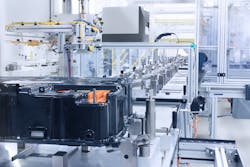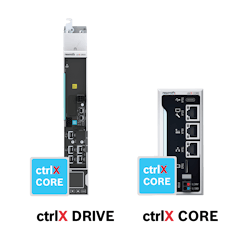A paradigm is typically defined as an outstandingly clear or typical example—a well-established and broadly understood pattern. A paradigm shift is a fundamental change in the basic concepts and practices of any discipline.
From that perspective, it's clear that many of the basic concepts, practices, and patterns of automation control are undergoing a significant paradigm shift.
New technologies, fresh software & hardware offerings, and revolutionary approaches to complete automation platforms are creating opportunities to build innovative machines and production lines that will have a transformative effect on a broad range of industries.
The direction of this shift is clear: automation will become more open, agile, and flexible to allow businesses to adapt manufacturing to changing market and global conditions.
Speed to market will become an even stronger driving force, and automation technology suppliers and machine builder OEMs will succeed in removing complexity from their systems to enable faster design, engineering, and implementation of the next generation of automation solutions.
Key Drivers for New Automation
In the early 2000s, automation platforms began to modernize, with the introduction of PC technology and PC-based automation taking control technology to a whole new level.
However, classic control systems still feature software architectures dating back 30, 40 or 50 years. Compared to modern IT systems, these legacy architectures, running on newer hardware, complicate the integration of value-added software and the use of open-source applications in automation platforms.
Rigid, complex automation systems are no longer suitable for today’s factories. The Industry 4.0 revolution has been accelerating the digitalization and connectivity in factories, requiring a whole new type of automation.
The recent impact of the COVID-19 pandemic, supply chain disruptions, and crucial semiconductor shortages have only added further momentum to the need for new automation approaches. Both end users and OEMs are pursuing new levels of modularity in the design of their production systems.
Instead of having machine functionality completely dedicated to one function, the new method is to use a modularized approach that treats different parts of the machine in sections that can be adapted, updated, and modified as needed—mainly through an open software concept.
Openness and modularity enable a key requirement that’s also growing in importance: scalability.
Machine builders want to create applications and functions for different-sized systems without having to start from scratch. To achieve that, machine builders call for hardware and software that is highly interchangeable.
One module of the machine can be designed independently from the other, from both a hardware and software perspective, with two separate controls running completely different apps. Yet, the whole machine works together because the underlying automation platform is connected, scalable, and open in ways that, in the past, had been expensive and time-consuming to accomplish.
Automation Enters the App Age
Scalability, openness, and connectivity already exist in the larger digital world, the world driven by the app. Major computing platforms, personal computers & tablets, and most significantly, smartphones are all built around the highly modular app concept—and now automation is joining that digital ecosystem.
New automation platforms such as Bosch Rexroth’s ctrlX AUTOMATION are moving the app-based approach forward aggressively.
Smartphone operating systems provide the foundation for an infinite array of specialized programs and apps that are easily downloaded and intuitive to use. They work seamlessly with the underlying operating system while providing focused functionality for a specific machine or production line system.
This interoperability has enabled constant creativity for outside developers to enhance smartphone functionality.
For automation OEMs and their end-user manufacturing customers, efficient engineering and straightforward application programming offer considerable potential for savings and much more freedom in system design.
App-driven software architecture allows OEMs to select the apps they need or to use any open-source software. In some instances, OEMs can develop modules themselves, using their expert automation and controls knowledge to create machine-specific apps in whatever popular programming language fits their needs.
Automation technology suppliers are creating “app stores” similar to the ones supported by Google and Apple. They provide an alternative source of compatible apps for specialized machine functions, such as vision inspection systems or predictive maintenance tools.
Using a “smartphone of automation” approach can help speed the development of complex applications that are essential parts of many production lines but are automated tasks that lie outside the core motion sequences.
For example, robotics and multiaxis handling systems are key functionalities in many production lines, with factory-floor intralogistics robots becoming more widely used every day. Cartesian systems, delta robots or SCARA robots must normally be engineered and adapted individually to particular workpieces or processes.
With an app-based approach, these functions can be downloaded and added to the automation platform, tested, and integrated into the system hardware much faster, with less risk of error and rework.
With this approach, some automation suppliers estimate that engineering costs, particularly related to software, could be reduced between 30 and 50%.
More Modular and Scalable Controllers
The paradigm shift in automation is also driving the launch of new controller platforms that offer more scalable, modular systems to replace the common PLC. These controllers are rapidly moving away from the closed, proprietary architectures of prior systems.
These new systems, such as Bosch Rexroth’s ctrlX CORE controller (part of the ctrlX AUTOMATION platform), feature high-performance firmware and hardware configurations like Linux-based multicore processors with the speed and sophistication to support demanding requirements.
With a multicore processor, one core can be dedicated just to machine control, while another core supports leading-edge apps like machine learning or database maintenance.
Equally important is that these new controllers support easy connectivity through open communications protocols such as Ethernet-based architectures and emerging standards like OPC.
This openness is also key to the controller’s scalability. Prior generations of controllers from some suppliers would force automation OEMs to integrate more costly controllers with more power or features than a given machine axis needed in order to use that controller for the whole machine.
The new generation of controllers can be scaled with additional apps so that, instead of having many different controllers with hardware-defined functionality, the core architecture lets the OEM scale as needed.
These controllers also make it easy for OEMs to remotely access the controller’s core to provide software updates, patches, and revisions—following the successful model used for major business applications and smartphone apps.
This open, remote access also supports a new approach to the entire process of engineering—virtual control and the digital twin.
Rather than performing all the programming of each drive and control on the actual device, a complete virtual implementation of the entire platform can be programmed, tested, and verified before loading it onto the new production machine or line.
This can be done remotely, practically eliminating the need to have one or more engineers on-site during development. Digital twins can be used to simulate the running automation system for select mechatronics or even the entire machine.
With the rapid growth of work-at-home situations, this makes it easier to attract top programming talent without having to convince them to relocate.
Apps Enable Concurrent Automation Engineering
A long-standing criticism of automation engineering is how time-consuming it can be, especially when launching whole new production lines. The typical two-year interval from the initial design to the first production run no longer aligns with the timelines that many manufacturers have. Increasingly, they need new machines or lines delivered in six to eight months or less.
At the same time, manufacturers want their factories to do more than just produce products. In the industry 4.0 era, they have automated data-gathering and real-time analytics built into their automation systems with user-friendly dashboards they can easily customize to provide actionable insights to improve operations.
In the past, features like these—or specialized HMI programming or security firewalls to protect machines from hacking—had to be programmed as part of one, big automation solution that often followed a step-by-step process that could extend the machine’s final delivery date.
With an app-based approach, the modularity and flexibility it provides makes it possible to use existing, proven third-party apps to enable all these capabilities on one platform.
All the different apps, written to run on an automation platform like ctrlX AUTOMATION, can connect to the platform and each other, communicate seamlessly, and enable functionality much more rapidly.
This makes it possible to carry out key automation engineering steps concurrently, ultimately making it possible to complete a new machine or production line in more compressed time frames. This is one more automation paradigm that will undergo a major shift as OEMs and system integrators begin exploring the full potential these platforms offer.
Advantages of a Total Automation Solution
A total automation portfolio—with app-driven software architecture, open interfaces, and scalable hardware options—provides the greatest value if it also includes drives, HMIs, I/O, and programming platforms that share common hardware, firmware, and software.
In these total platforms, system functions complement each other and can also be extended by apps and third-party hardware and software. Superior connectivity is supported with virtually all relevant automation protocols, as well as offering freedom in the choice of development environment and programming language.
Working with technology suppliers that are fully invested in driving the development of these transformative automation platforms can help machine builders, system integrators, and end users to take full advantage of the paradigm shift in automation.
About the Author

Dave Cameron
Sales Director, Automation and Electrification - Bosch Rexroth
Dave Cameron has been the sales directory for Bosch Rexroth since 2015. He has over 25 years of engineering and sales experience in industrial automation with expertise in control systems and the application of software and hardware in industrial machinery.


